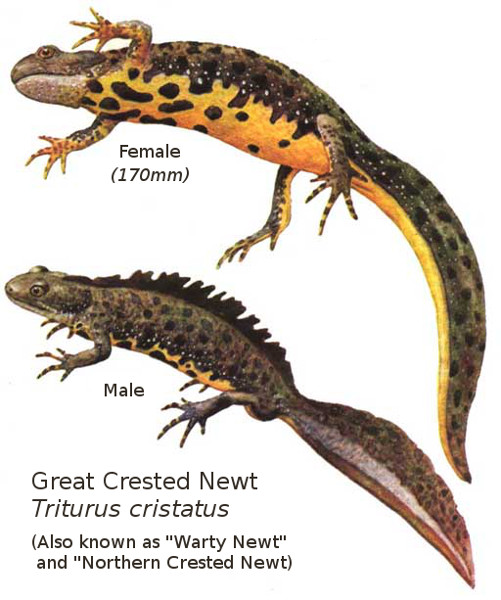
Scientific Name: Triturus cristatus
Conservation Status: Protected (Habitats Directive, UK Biodiversity Action Plan Priority Species)
The Great Crested Newt, often called the “warty newt,” is one of the UK’s most charismatic amphibians. Recognizable by its dramatic crest and striking coloration, this species can be a fascinating addition to your garden pond’s ecosystem.
Great Crested Newts thrive in unpolluted, still freshwater habitats such as ponds, marshes, and ditches. They prefer ponds with abundant aquatic vegetation, which provides shelter and breeding grounds. If you have a garden pond, planting native aquatic plants and creating gentle, sloping edges can make it more suitable for these newts. Surrounding areas, like wildflower borders, woodpiles, and hedgerows, offer essential terrestrial shelter for foraging and hibernation.
For help finding the right native aquatic plants, visit Aqua Eden. We offer a wide selection of plants ideal for creating a newt-friendly environment.
The lifecycle begins in early spring (March-May), when adults return to ponds to breed. Females lay eggs individually, wrapping each in leaves or aquatic plants. Larvae hatch in 2-4 weeks and develop into juveniles (known as efts) by late summer, leaving the water by autumn. Adults spend most of their lives on land, returning to water only to breed.
Adults typically measure 12-17 cm in length, with males slightly larger than females. In the wild, Great Crested Newts can live up to 14 years, though 6-10 years is more common.
This species faces threats from habitat loss, pollution, and invasive species. It is legally protected under UK and European law, making it illegal to capture, harm, or disturb them or their habitats.
Great Crested Newts are most visible during their breeding season (March to June). Look for them in your pond during twilight or night, when they’re most active.
Males boast a jagged, sail-like crest during breeding season and a vibrant orange belly speckled with black spots. Females are less vivid but share the belly pattern. Both sexes have warty, dark brown to black skin, providing excellent camouflage on land.
To attract and protect Great Crested Newts, consider the following:
For help selecting native aquatic plants, visit Aqua Eden to explore our wide range of options that support Great Crested Newts and other wildlife.
By making these small changes, you can help conserve this incredible species while enjoying a vibrant and thriving garden pond.
Learn more about this fantastic creature from great charities like Froglife

Aqua Eden, Jordans Courtyard,
Ilminster, TA19 9PY
Open Tue-Fri 9am – 3pm
enquiries@AquaEden.co.uk
We’re the South West’s newest Water Garden Centre and Design Studio, nestled in the heart of Jordans Courtyard, Ilminster, just off the A303 and J25 of the M5. Whether you’re looking to enhance an existing water feature or create a brand new oasis, we’re here to inspire, educate, and empower you on your water gardening journey. Our friendly, knowledgeable team is passionate about helping you bring your watery dreams to life, and we’re with you every step of the way.
If you’d prefer to leave it to the professionals, our partner company, DU Waterscapes, brings years of experience and expertise to the table. As award-winning water feature artists, they offer expert maintenance and custom installations tailored to your needs. Experience their stunning displays at Aqua Eden and discover how they can bring a slice of Eden to your home. Learn more on their website!